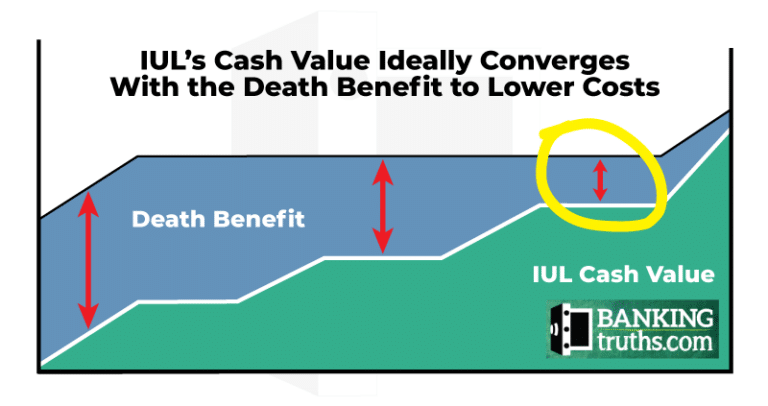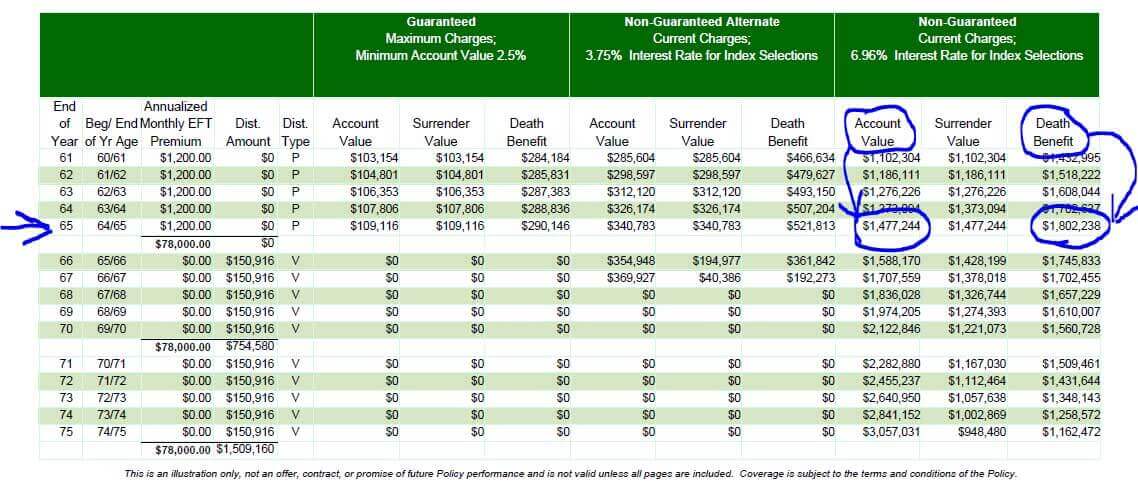All Categories
Featured
Table of Contents
For making a minimal quantity of the index's growth, the IUL will never ever obtain less than 0 percent passion. Also if the S&P 500 decreases 20 percent from one year to the following, your IUL will not shed any type of money worth as a result of the marketplace's losses.

Think of the passion worsening on a product with that kind of power. Given all of this information, isn't it conceivable that indexed global life is an item that would allow Americans to get term and spend the rest?
A real financial investment is a safety and securities product that goes through market losses. You are never ever based on market losses with IUL just because you are never ever based on market gains either. With IUL, you are not purchased the market, yet simply earning rate of interest based on the efficiency of the market.
Returns can expand as long as you remain to pay or keep a balance. Contrast life insurance online in minutes with Everyday Life Insurance Policy. There are two kinds of life insurance coverage: long-term life and term life. Term life insurance policy only lasts for a certain duration, while irreversible life insurance coverage never expires and has a cash worth part in addition to the survivor benefit.
What Is A Roth Iul
Unlike global life insurance, indexed universal life insurance's cash money worth makes rate of interest based on the performance of indexed stock markets and bonds, such as S&P and Nasdaq., mentions an indexed global life plan is like an indexed annuity that really feels like global life.

Universal life insurance was developed in the 1980s when rate of interest prices were high. Like other kinds of long-term life insurance, this plan has a cash money worth.
Indexed global life policies offer a minimal guaranteed interest price, additionally known as a rate of interest attributing floor, which reduces market losses. Say your money value loses 8%.
Ul Mutual Life Insurance
It's also best for those happy to assume added threat for greater returns. A IUL is a long-term life insurance policy plan that borrows from the buildings of a global life insurance policy plan. Like global life, it permits adaptability in your death advantage and costs repayments. Unlike global life, your money worth grows based upon the efficiency of market indexes such as the S&P 500 or Nasdaq.
Her work has actually been released in AARP, CNN Underscored, Forbes, Ton Of Money, PolicyGenius, and United State Information & Globe Report. ExperienceAlani has examined life insurance policy and animal insurance provider and has actually created many explainers on travel insurance, credit rating, debt, and home insurance. She is passionate regarding demystifying the complexities of insurance policy and various other personal finance subjects so that visitors have the details they need to make the ideal money choices.

Paying just the Age 90 No-Lapse Premiums will ensure the survivor benefit to the insured's achieved age 90 yet will certainly not assure cash money worth accumulation. If your client discontinues paying the no-lapse warranty premiums, the no-lapse attribute will terminate prior to the ensured period. If this happens, additional premiums in a quantity equal to the shortage can be paid to bring the no-lapse attribute back effective.
I just recently had a life insurance coverage sales person turn up in the remarks thread of an article I released years ago concerning not mixing insurance policy and investing. He assumed Indexed Universal Life Insurance Coverage (IUL) was the best thing given that sliced bread. On behalf of his setting, he published a link to a post composed in 2012 by Insurance Policy Agent Allen Koreis in 2012, qualified "16 Reasons that Accountants Prefer Indexed Universal Life Insurance Coverage" [web link no more offered]
Iul Companies
However, initially a brief explanation of Indexed Universal Life Insurance. The tourist attraction of IUL is noticeable. The facility is that you (virtually) get the returns of the equity market, without any kind of danger of shedding money. Currently, before you diminish your chair poking fun at the absurdity of that statement, you require to realize they make a very persuading argument, at the very least until you take a look at the information and recognize you do not obtain anywhere near the returns of the equity market, and you're paying far way too much for the guarantees you're getting.

If the market drops, you obtain the ensured return, usually something between 0 and 3%. Of course, since it's an insurance coverage, there are likewise the typical prices of insurance coverage, payments, and surrender costs to pay. The information, and the reasons that returns are so dreadful when mixing insurance and investing in this certain way, boil down to basically 3 points: They only pay you for the return of the index, and not the returns.
Universal Life Insurance Comparisons
Your optimum return is covered. If you cap is 10%, and the return of the S&P 500 index fund is 30% (like last year), you get 10%, not 30%. Some plans only offer a particular portion of the adjustment in the index, claim 80%. So if the Index Fund rises 12%, and 2% of that is dividends, the adjustment in the index is 10%.
Add all these impacts together, and you'll discover that long-lasting returns on index universal life are pretty darn near to those for entire life insurance policy, favorable, however reduced. Yes, these policies assure that the cash money value (not the cash that mosts likely to the expenses of insurance coverage, obviously) will not shed cash, however there is no assurance it will certainly stay up to date with rising cost of living, much less expand at the rate you need it to expand at in order to attend to your retirement.
Koreis's 16 factors: An indexed global life policy account value can never ever lose money as a result of a down market. Indexed universal life insurance coverage assurances your account worth, locking in gains from each year, called a yearly reset. That's real, but just in small returns. Ask on your own what you require to pay in order to have an assurance of no nominal losses.
In investing, you obtain paid to take risk. If you don't desire to take much risk, do not anticipate high returns. IUL account values grow tax-deferred like a certified plan (IRA and 401(k)); mutual funds don't unless they are held within a certified plan. Merely put, this means that your account value gain from triple compounding: You gain interest on your principal, you gain rate of interest on your passion and you make passion accurate you would otherwise have paid in taxes on the rate of interest.
Cost Insurance Life Universal
Although qualified strategies are a much better option than non-qualified plans, they still have problems absent with an IUL. Financial investment options are generally limited to common funds where your account value goes through wild volatility from direct exposure to market danger. There is a big distinction in between a tax-deferred retirement account and an IUL, yet Mr.
You purchase one with pre-tax dollars, minimizing this year's tax costs at your marginal tax price (and will certainly often be able to withdraw your money at a lower efficient rate later) while you purchase the other with after-tax bucks and will be forced to pay interest to borrow your own cash if you do not wish to give up the plan.
He tosses in the classic IUL salesman scare strategy of "wild volatility." If you dislike volatility, there are far better ways to reduce it than by purchasing an IUL, like diversity, bonds or low-beta stocks. There are no limitations on the quantity that may be contributed yearly to an IUL.
:max_bytes(150000):strip_icc()/Pros-and-cons-indexed-universal-life-insurance_final-1b83c0fd52154eb69edd47f99ab8927a.png)
Why would the federal government put limits on exactly how much you can place right into retirement accounts? Maybe, simply perhaps, it's due to the fact that they're such a great bargain that the federal government does not want you to conserve also much on tax obligations.
Latest Posts
Universal Life No Lapse Guarantee
Index Universal Life Insurance With Long Term Care
Universal Insurance Payment